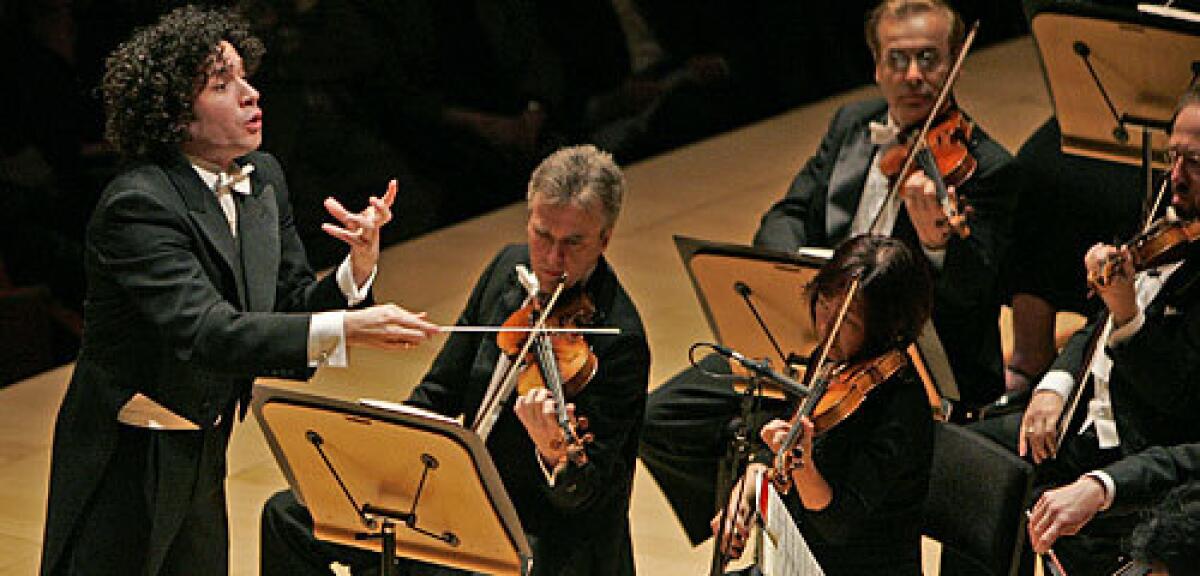Live: Gustavo Dudamel and the L.A. Philharmonic

In some respects, D-day at Walt Disney Concert Hall resembled many another Friday night concert by the Los Angeles Philharmonic. A young man conducted. Another young man played the piano. The hall was full, and listeners sat respectfully through the program, saving their gusto for standing ovations.
But the normalcy was only on the surface. Gustavo Dudamel was leading the orchestra for the first time since the surprise announcement a year ago that he would succeed Esa-Pekka Salonen as music director of the orchestra in 2009. The result was an evening without a dull moment, buoyed by expectations that were almost impossibly high. No appointment of a music director in America has captured the imagination of such a wide public since Leonard Bernstein took over the New York Philharmonic in 1958.
Wednesday night, Dudamel, who trained as a violinist, had joined a few Philharmonic players for a spot of chamber music. Although he played only second violin in Mozart’s Clarinet Quintet, he was lustily cheered by an unusually rambunctious audience.
Still, that unusual scene for the orchestra’s usually low-key chamber music series occurred mainly because chamber music attracts a far smaller subscriber base than symphony concerts and because ticket prices are considerably cheaper. Seats were available, and people snapped them up if only for a modest glimpse of Dudamel. His concerts with the orchestra last week and this have long been sold out.
No one could accuse Dudamel of modesty. He is far too charismatic to be contained. But in this first orchestral program as music director-designate, he took pains to pay tribute to the orchestra’s present music director by beginning with Salonen’s “Insomnia.” Of course, Dudamel conducted it his way.
Written shortly after the terrorist attacks of Sept. 11 and lasting about 20 minutes, “Insomnia” is Salonen’s darkest large orchestral score. The piece alternates between a moody chorale, with folk music-like filigree, and the intricate machine-like passages that Salonen so likes. Swelling climaxes are bold and powerful. Four Wagner tubas, strange-sounding instruments, add to the sometimes ominous character of the piece.
Salonen describes his score as representing one of those sleepless nights when unwanted thoughts won’t leave you alone. Finally you get sleepy, but just as you are about to lose consciousness, the sun rises in all its glory.
Dudamel, however, does not appear to waste energy tossing and turning. Can’t sleep? Then turn on the lights. Better still, go out dancing. Salonen’s performances of “Insomnia” tend to focus on his music’s masterly inner workings as well as his compelling rhythmic exactitude, keeping his heart sometimes obscured by his sleeve. Dudamel, on the other hand, threw himself into the performance with a get-up-and-go spirit.
He didn’t altogether ignore the Finnish design, and in fact he brought out some of the bits of Sibelius (the swooping brass lines, the wind whipping through the woodwinds) that Salonen underplays. But the Venezuelan also turned up the heat, attacking every passage with passion, demonstrating just how much fun he can find in complicated modern scores.
Prokofiev’s First Piano Concerto, which followed, is very much music best left to the young. The composer was a 20-year-old student when he wrote it in 1911 to show off as pianist and composer. A pianist can get away with murder in such irresistibly freewheeling music. Simon Trpceski, a 28-year-old Macedonian pianist with a major record contract from EMI, got away with murder.
Trpceski has a big, muscular technique and a big ego. Dudamel gave him plenty of leeway, and the pianist hot-rodded through the fast passages as if he was out to set speed records. He swooned through slow, lyrical moments but swooned with a strikingly beautiful tone.
Throughout the concerto, Dudamel appeared to be enjoying himself greatly, and afterward he urged the soloist to play an encore and sat on the podium listening while Trpceski gave an eloquent account of Debussy’s First Arabesque.
After intermission, Berlioz got the full, highly charged, dripping-with-color Dudamel treatment -- a fabulous, in-your-face “Symphonie Fantastique.” Berlioz portrays drug-induced dreams and nightmares. Dudamel added Technicolor, wide screen and multichannel sound in an avid performance that underscored absolutely everything he could possibly underscore.
The symphony begins dreamily, but the minute he got the chance to inject rhythmic action, Dudamel grabbed it, punching out rhythms, urging cellos and basses into viscerally raw attacks, pushing everyone to give 110%. In the “March to the Scaffold” movement, in which Berlioz imagines his own execution, Dudamel maintained intensity while delighting in all the weird instrumental effects Berlioz came up with. The “Witches’ Sabbath” was deliriously over the top.
Something is unquestionably happening at the Philharmonic. The audience may have behaved itself Friday, but electricity was in the air.
More to Read
The biggest entertainment stories
Get our big stories about Hollywood, film, television, music, arts, culture and more right in your inbox as soon as they publish.
You may occasionally receive promotional content from the Los Angeles Times.







